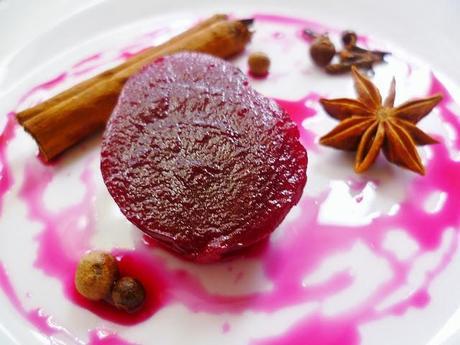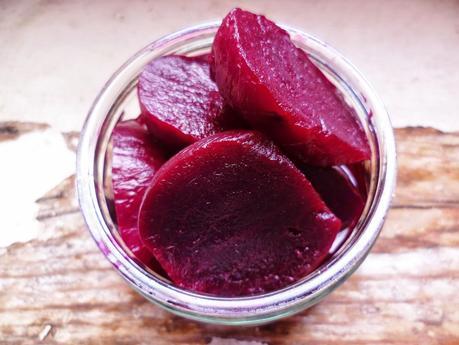
a piece of pickled beetroot surrounded by pickling spices
I have mentioned before that my early horror of beetroot was caused by my late father, Henry’s love of pickled beetroot. For a man who didn’t really like to argue, Henry had the perfect way to forestall an argument with me. He would just go to the kitchen, rummage around in the cupboards and triumphantly produce a jar of pickled beetroot. It was if I was some kind of argumentative vampire. But instead of garlic or silver bullets, he had a jar of pickled beetroot with which to ward me off. He wouldn't even have to open the damned thing, before I had fled in horror!But over the past few years, having overcome my dislike of coriander and bananas, I decided to work on beetroot. And very slowly, I have learned to like raw and cooked beetroot. Now has come the time to venture closer to the dark side, and learn to like, if not love, pickled beetroot.

spiced pickled beetroot
It is well-known that the colours we see in our food also affect our perception of flavour. Colourful plates of food are far more appealing than monotonous or bland ones. We really do "eat with our eyes." So in talking of colour, I adore rich dark pinks, purples and red. The content of my (deeply unfashionable) wardrobe displays a distinctly liturgical hue in that so many of my clothes include rich beetroot colours. My lipstick is a deep red, my nail polish the same. At several points over the last few years, even my hair has been a vibrant dark pink-red color. I love the color for its rich sumptuousness. It speaks of medieval tapestries, old paintings and dusty theater curtains. It screams Arabian Nights or Aladdin’s cave of beautiful gemstones. It really is rather magical.So if I love the damned color so much, why don't I much care for a vegetable that screams colour? So the time has come to conquer my greatest fear - pickled beetroot. And despite viewing this with a little trepidation, I decided to include my favorite spices and use white wine vinegar, rather than the pungent malt vinegar so beloved of my father. Frankly malt vinegar just doesn’t do beetroot any favours.
As for how it turned out . . . rather well, if I say so myself. It is sweetly aromatic. Although I still don’t think I’ll be including it in Henry’s favorite pickled beetroot and piccalilli sandwich any time soon!
ingredients:
300ml white wine vinegar
200ml water
200g sugar (I used granulated)
1 tsp salt
1 x cinnamon stick, broken
1 x star anise
4 x cloves
3 x allspice berries
5 x green cardamom pods, pierced or crushed
3 x bay leaves
directions:
- Sterilise a large pickling jar such as a kilner jar, (see instructions in the tips below).
- Preheat the oven to 180C / Gas Mark 4.
- Trim any of the beetroot leaves and stems, leaving about a 1 centimeter stub. If the leaves and stems look fresh, then stick in a jug of water to perk up, before using in a salad.
- Wash the beetroot and then wrap each beetroot in a square of kitchen foil with a splash of water. Place on a baking tray and bake for about 1 hour until the beetroot feels slightly soft. You should be easily able to insert the point of a sharp knife at this stage. Set aside to cool.
- Once cool enough to handle, peel the cooked beetroot. Slice the beetroot, (and keep small ones whole.) Pack into the sterilised jar.
- Prepare the pickling vinegar by combining the sugar, white wine vinegar and water in a non-reactive saucepan. Bring to the boil and then simmer until the sugar has dissolved, stirring occasionally. Add the spices and simmer for 5 minutes.
- Pour the vinegar and spices over the cooked beetroot and set aside, uncovered, to cool. Once cool, seal tightly and store in a cool dark place or in the fridge.
- A quick way to clean and sterilise jars is to put them on a hot wash in a dishwasher. For those of us who do not have dishwashers (well me - I am my own dish-washer!), then wash the jars and lids in hot soapy water, then rinse well in very hot water. Place jars and lids in the oven at 160C / Gas Mark 3 for about 20 minutes. If using a dishwasher you can skip this stage. Use vinegar-proof lids - you can tell which ones these are by the ring of white plastic on the underside of the lid. Alternatively use those lovely spring-clip French pickling jars, which look decorative too.

